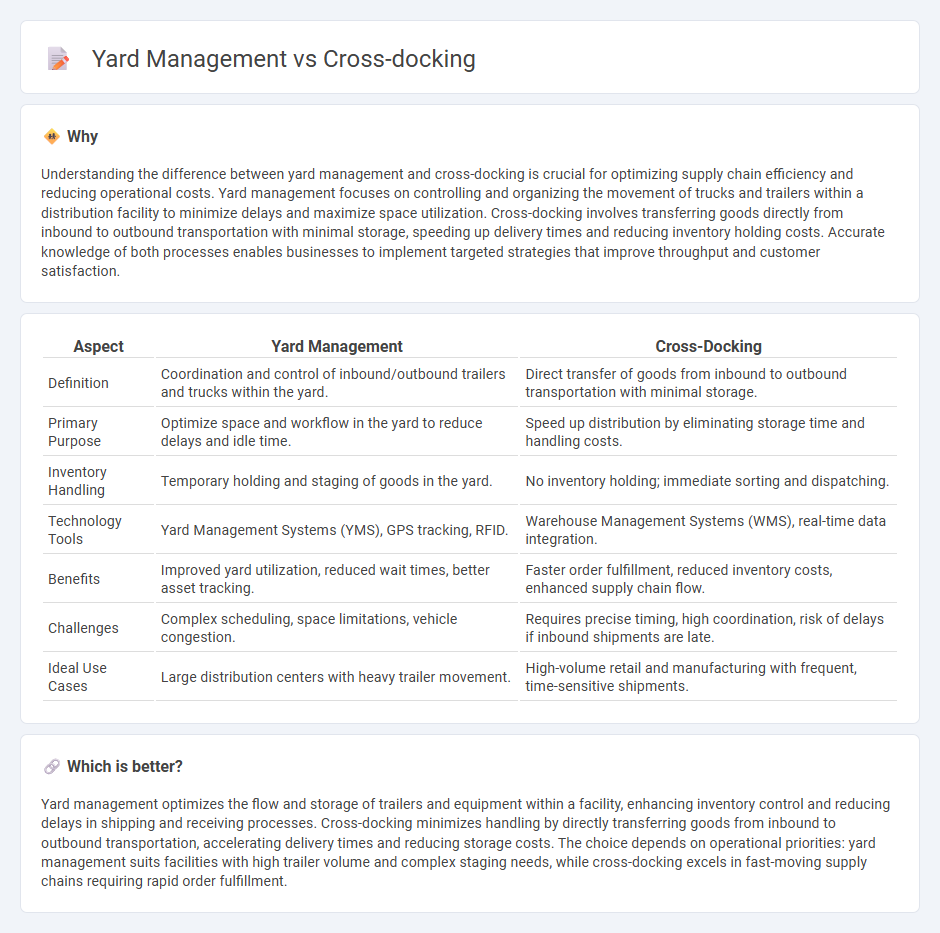
Yard management focuses on efficiently coordinating the movement and storage of trailers and vehicles within a logistics facility, optimizing dock door assignments and reducing yard congestion. Cross-docking minimizes storage by directly transferring goods from inbound to outbound transportation, accelerating order fulfillment and lowering inventory holding costs. Explore the key differences and advantages of yard management versus cross-docking to enhance your supply chain operations.
Why it is important
Understanding the difference between yard management and cross-docking is crucial for optimizing supply chain efficiency and reducing operational costs. Yard management focuses on controlling and organizing the movement of trucks and trailers within a distribution facility to minimize delays and maximize space utilization. Cross-docking involves transferring goods directly from inbound to outbound transportation with minimal storage, speeding up delivery times and reducing inventory holding costs. Accurate knowledge of both processes enables businesses to implement targeted strategies that improve throughput and customer satisfaction.
Comparison Table
| Aspect | Yard Management | Cross-Docking |
|---|---|---|
| Definition | Coordination and control of inbound/outbound trailers and trucks within the yard. | Direct transfer of goods from inbound to outbound transportation with minimal storage. |
| Primary Purpose | Optimize space and workflow in the yard to reduce delays and idle time. | Speed up distribution by eliminating storage time and handling costs. |
| Inventory Handling | Temporary holding and staging of goods in the yard. | No inventory holding; immediate sorting and dispatching. |
| Technology Tools | Yard Management Systems (YMS), GPS tracking, RFID. | Warehouse Management Systems (WMS), real-time data integration. |
| Benefits | Improved yard utilization, reduced wait times, better asset tracking. | Faster order fulfillment, reduced inventory costs, enhanced supply chain flow. |
| Challenges | Complex scheduling, space limitations, vehicle congestion. | Requires precise timing, high coordination, risk of delays if inbound shipments are late. |
| Ideal Use Cases | Large distribution centers with heavy trailer movement. | High-volume retail and manufacturing with frequent, time-sensitive shipments. |
Which is better?
Yard management optimizes the flow and storage of trailers and equipment within a facility, enhancing inventory control and reducing delays in shipping and receiving processes. Cross-docking minimizes handling by directly transferring goods from inbound to outbound transportation, accelerating delivery times and reducing storage costs. The choice depends on operational priorities: yard management suits facilities with high trailer volume and complex staging needs, while cross-docking excels in fast-moving supply chains requiring rapid order fulfillment.
Connection
Yard management optimizes the movement and storage of inbound and outbound trailers, ensuring efficient dock door assignments and minimizing delays. Cross-docking relies on precise yard management to synchronize the immediate transfer of goods from receiving to shipping docks, reducing storage time. Together, they streamline supply chain operations by accelerating inventory flow and decreasing warehouse handling costs.
Key Terms
**Cross-docking:**
Cross-docking streamlines supply chain operations by directly transferring products from inbound to outbound transport, minimizing storage time and reducing inventory costs. It enhances efficiency through synchronized scheduling, real-time tracking, and precise load consolidation, facilitating faster order fulfillment and lowering handling risks. Explore how integrating advanced cross-docking strategies can optimize logistics workflows and improve delivery speed.
Transfer Point
Cross-docking streamlines the transfer point by minimizing storage time, enabling goods to move directly from inbound to outbound transportation, reducing handling costs and delivery times. Yard management optimizes the transfer point by coordinating the movement and staging of trailers within the facility to prevent congestion and improve dock door utilization. Explore advanced strategies to enhance transfer point efficiency through integrated cross-docking and yard management solutions.
Dock Scheduling
Cross-docking optimizes inventory flow by transferring goods directly from inbound to outbound trailers, minimizing storage time and enhancing dock scheduling efficiency. Yard management focuses on coordinating trailer movements within the yard to prevent congestion and ensure timely dock assignments, crucial for seamless operations. Discover how integrating dock scheduling in both cross-docking and yard management boosts warehouse productivity and reduces turnaround times.
Source and External Links
Cross Docking: Definition, History, and Process - Inbound Logistics - Cross docking is a shipping method transferring goods directly from inbound to outbound transportation with minimal storage, using methods like continuous flow, consolidation, and de-consolidation to optimize time and space.
What Is Cross-Docking? Definition, Types & Advantages - NetSuite - Cross-docking is a supply chain technique that directly transfers goods from inbound to outbound trucks or railcars with little or no storage, enabling faster delivery, reduced costs, and minimized warehouse use.
Understanding cross-docking: A comprehensive guide - Maersk - Cross-docking is a logistics process where products move from suppliers directly to customers or next destinations with minimal storage, including types such as pre-distribution, post-distribution, continuous, consolidation, and deconsolidation tailored to various industries.
 dowidth.com
dowidth.com